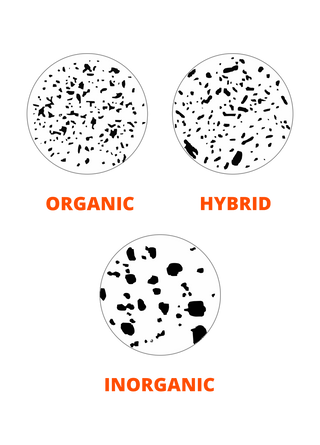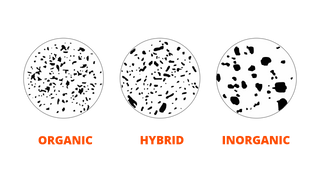Pigmentos inorgánicos vs. orgánicos
¿Qué es Pigment for PMU?
En el ámbito del maquillaje permanente (PMU), los pigmentos desempeñan un papel crucial en el resultado y la duración del procedimiento. Los pigmentos para PMU se componen de pigmentos de color secos suspendidos en una base líquida, a menudo denominada disolvente. El pigmento seco proporciona el color, mientras que el disolvente facilita la aplicación y la estabilidad del pigmento. A continuación, se muestra una infografía que ilustra esta composición.


Tipos de pigmentos de color secos
Los pigmentos de color secos utilizados en PMU se pueden clasificar en tres categorías principales:
Pigmentos orgánicos : se producen sintéticamente en laboratorios y son conocidos por su tamaño de partícula más pequeño y sus colores vibrantes.
Pigmentos híbridos : combinan elementos de pigmentos orgánicos e inorgánicos, ofreciendo un equilibrio de vitalidad y estabilidad.
Pigmentos inorgánicos : suelen derivar de minerales naturales y se caracterizan por su mayor tamaño de partícula y tonos más terrosos.
Características de los pigmentos orgánicos e híbridos
Pigmentos orgánicos :
Elaborado en laboratorios, garantizando consistencia en color y calidad.
Tamaño de partícula más pequeño, lo que da como resultado colores más brillantes y vibrantes.
A menudo se prefieren por su facilidad de aplicación y los finos detalles que pueden lograr.
Pigmentos híbridos :
Combine pigmentos orgánicos con componentes inorgánicos para mejorar la estabilidad y la retención del color.
Ofrece un punto medio entre la vitalidad de los pigmentos orgánicos y la durabilidad de los pigmentos inorgánicos.
Características de los pigmentos inorgánicos
Pigmentos inorgánicos :
Se encuentra en la naturaleza y generalmente se extrae de minerales.
Tamaño de partícula más grande, lo que produce colores más apagados y de aspecto más natural.


Selección de pigmentos inorgánicos
Selección de pigmentos híbridos
Diferencias en la aplicación y recomendaciones
La elección entre pigmentos orgánicos e inorgánicos depende en gran medida del resultado deseado y del tipo de piel del cliente:
Pigmentos orgánicos :
Recomendado para detalles finos y colores vibrantes, como delineado de ojos o cejas. Son especialmente adecuados para clientes con piel normal a seca.
Pigmentos inorgánicos :
Ideal para clientes que buscan un aspecto más natural o aquellos con piel grasa, ya que estos pigmentos tienen menos probabilidades de migrar y ofrecen resultados más duraderos.
Índice de color (CI) para pigmentos orgánicos e inorgánicos
Cada pigmento utilizado en PMU tiene un número de índice de color (CI) que identifica su composición química:
CI para pigmentos orgánicos : generalmente están en el rango de CI 1xxxx a CI 5xxxx.
CI para pigmentos inorgánicos : estos suelen estar dentro del rango de CI 7xxxx a CI 8xxxx.
Cómo diferenciar los pigmentos orgánicos de los inorgánicos
Hay varios experimentos sencillos que puedes realizar para diferenciar entre pigmentos orgánicos e inorgánicos:
Experimento con imán
Los pigmentos inorgánicos suelen contener elementos metálicos, que pueden detectarse con un imán. Simplemente coloque una pequeña cantidad de pigmento sobre una hoja de papel y acerque un imán. Si el pigmento se mueve hacia el imán, es probable que sea inorgánico.


En el experimento del vidrio
Mezcle una pequeña cantidad de pigmento con agua en un vaso. Los pigmentos inorgánicos tienden a depositarse en el fondo, mientras que los pigmentos orgánicos/híbridos pueden permanecer suspendidos o disolverse de forma más uniforme.


Experimento con disco de algodón
Coloque una gota de pigmento en un disco de algodón. Los pigmentos inorgánicos suelen dejar una marca más pronunciada y menos difusa, mientras que los pigmentos orgánicos se extienden de forma más uniforme.


El resultado final
Comprender las diferencias entre los pigmentos orgánicos e inorgánicos es esencial para lograr los resultados deseados en la PMU. Mientras que los pigmentos orgánicos ofrecen intensidad y precisión, los inorgánicos brindan estabilidad y durabilidad. Al considerar el tipo de piel del cliente y la aplicación específica, los artistas de la PMU pueden tomar decisiones informadas para garantizar los mejores resultados posibles.
En SupremePermanent.com, ofrecemos pigmentos híbridos e inorgánicos . Encontrar pigmentos inorgánicos puros, como Contur, es cada vez más difícil.
Históricamente, los pigmentos inorgánicos tendían a enrojecerse con el tiempo. Para solucionar esto, muchos fabricantes comenzaron a añadir pigmentos orgánicos amarillos a los pigmentos inorgánicos, mejorando así la estabilidad del color a largo plazo.
Además, el óxido de hierro negro suele reforzarse con una pequeña cantidad de negro de humo para mantener un color negro estable durante más tiempo después de la implantación. Esta combinación ayuda a lograr un mejor equilibrio en el rendimiento y la longevidad del pigmento en la piel, sin dejar de considerarse inorgánico.
Para identificar qué líneas de pigmentos inorgánicos tienen componentes orgánicos agregados, simplemente lea la lista de ingredientes en cada botella de pigmento.




















